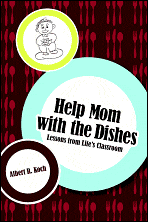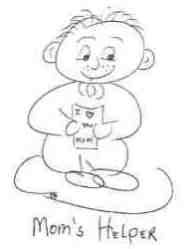From early on, we are set upon to learn skills, perform tasks, pursue jobs and a sundry of ancillary applications which are designed increase the quality of life, accelerate economic worth, promote self reliance, refine personal independence, encourage the willing acceptance and adoption of emerging technology, solidify personal and social values to our lifestyle and add to the overall daily enjoyment of living.
The problem is that everything moves so fast, as one master’s new technology it is already obsolete and has to be set aside for emerging knowledge demanding attention.
I have a whole list of skills that most likely will not be called be called upon: ironing clothes. Before permanent press everything was ironed. By fourth grade, I was skilled at towels, bedclothes, shirts, jeans, and household linens. I also know how to sew and cook. But with today’s microwave and fast-fix methods, who needs to know how to make something from scratch. From entrees to baked goods, it is simply out of the box in the microwave and ZAP! Sewing skills are another matter. To this day I can reattach a button, mend a hem, or replace a few well-worn stitches.
Early on, I learned by trial and error how to repair a Bendix bicycle brake, repair punctured inner tubes and patch tires so my mobility would not be adversely limited. I was very good at shoveling coal into the bin, leveling it out, installing the next gate board and climbing out with a minimum of coal dust affixed to my clothes. I also knew how to remove clinkers from the family’s furnace on cold frozen winter mornings. I learned how to thread a movie projector—both silent and sound—and used that skill as a “chick magnet” in school. To be an “AV” kid was high celebrity! School was also where I learned to run a Ditto machine. Benefits? The perfume of the activating fluid was incentive enough to run “extra” copies for teachers.
Another skills was putting up and taking down storm and screen windows. Each sash was numbered and had to be matched in order for the unit to fit properly. Unfortunately, a side bar of that endeavor was washing windows. Ammonia, vinegar, and elbow grease galore—was a way to destroy an early fall Saturday morning.
As a student at Whiting High, I learned how to typewrite, take shorthand, and set type by hand in the print shop for the school’s newspaper: THE TATTLER. And, perhaps, the skill I was most proud and leaned the greatest lessons from—setting pins at the Whiting Community Center. Each of these manipulative and cognitive tasked served me well; each skill had ancillary branches that could be adapted, modified, used innovatively for a future task. The Machine Shop at Whiting High School was the place where I discovered metalworking skills, talents, and employment possibilities. Coupled with my college-prep courses, when I graduated from Whiting I had a solid foundation upon which future education would be grounded.
Not too long ago, I was musing about some to the “stuff” that has come and gone—technology, lifestyles, gadgets—that made growing up such a joy. In no particular order, here is a random list of good obsolescence—lifetime’s badges of honor:
Pay phone, rotary telephones and cozy phone booths; full service gas stations—the customer was treated with celebrity; telephone operators, party lines, push-button Trimline phones, TV roof antennas—the ultimate social status symbol of the fifties! Parochial grade school nuns dressed like nuns! Home delivery and repair services: milkman, bakery, farmer, TV repairman, and groceries. Milk that came in glass bottles, beer openers-- “church keys” for canned beer and pop; soda fountains where phosphates and sodas, and milk shakes reigned! The soundtrack of boyhood summers featured reel-to-reel lawnmowers as they went about trimming and cutting neighborhood lawns.
Music transformed almost daily: vacuum tubes to transistors, heavy, unwieldy portable battery packs to a single nine-volt battery. Shellac replaced vinyl for records and turntables modified speed from 78 to 45 rpm. When the long-playing album debuted a full fifteen minutes of music could be played on a single side at 33-1/3 rpm. There were music stores where we could audition the newest hits. Other hometown establishments had Jukeboxes that featured the most popular song of the moment, and stereo systems that encouraged higher amplification, range, quality of sound and quantity of speakers. Car radios boomed with Top 40 hits as street sleds visited their favorite Drive-In hangout to check out the competition’s wheels, menu, and all things adolescent. Drive-In Movies were the place to be seen. Today, almost extinct, how does one explain the summer’s delight of an outdoor movie under the stars with buddies, sweethearts, romantics and families all enjoying Hollywood’s latest film in the total independence of one’s automobile? I made specially fitted window screens in order to defeat pesky mosquitoes.
How quickly flash bulbs and movie cameras passed into time! Polaroid came, dazzled, and evolved into other more electronic devices. I miss the Shoreline Buses. White wall tires—once the rage are now nowhere to be found. Vinyl tops, black and white TV’s automobile hubcaps, spinners, and a whole catalog of gadgets for the car. I once installed a 45rpm record player so I could listen to my favorite 45 on demand. Wasn’t that ahead of its time!
From the sophisticated to the sublime—fine fountain pens, to pin ball machines, gadgets that filled and enrich youthful times. Today, everything is different. For instance: High school class rings were once purchased by the whole class. Each ring was the same color, design and material. We chose the ring to reflect our friendship, bond, allegiance and appreciation to our high school and classmates. Today, that’s obsolescence. For me: it is one of lifetime’s badges of honor.
Subscribe to:
Post Comments (Atom)
Where's Al going to be next???
Check back soon for his next appearance at a location near you!


No comments:
Post a Comment